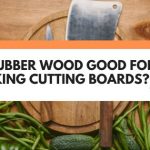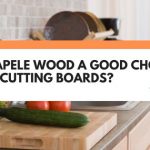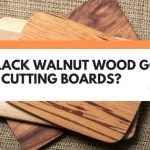Cutting boards can be made from various types of materials.
But, the result is still the same for all of them. That’s because a good cutting board is simply one that can provide a safe food prepping surface.
Which is why good old fashioned wood is one of the most food safe cutting board materials.
Still, only a limited range of woods are ideally suited for the hard life of a cutting board. But, is Pecan wood one of them?
Well, in this post, you’ll discover the key three criteria that all cutting board material must meet. You’ll also learn why not all wood types make for a sanitary food prep surface.
And keep reading to find out which North American hardwood is perfect for making cutting boards with.
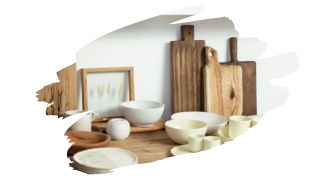
This post may contain affiliate links to products that we receive a commission for (at no additional cost to you). Learn more here.
What Is The Best Type Of Material For A Cutting Board?
Cutting board material needs to meet three key criteria;
- A). It must be easy to keep sanitary and clean.
- B). It must be hard enough to be able to absorb the impact of a chopping knife.
- C). But, it mustn’t be so hard that it ends up damaging your cookware.
Based on this, the top four best materials for a chopping block are wood, bamboo, plastic, and rubber.
OK… But What Is The Best Kind Of Wood For A Cutting Board?
This is where things get a little bit interesting. Not all types of wood are equally suited for becoming a food prepping surface.
You see, wood types that have large open pores, (such as Red Oak), are fairly hard to keep clean of food bits.
That’s because little morsels of food can get caught up in the pores of these types of wood. And once that happens, this can make it all too easy for harmful bacteria to grow on your cutting board.
Or worse, they can increase the risk of raw food cross-contamination.
Another thing you need to check for, when selecting cutting board lumber, is the wood’s toughness. A cutting board needs to be hard enough to take on chops, but not so tough that it wrecks your kitchen cookware.
Related Post: What Food Grade Wood Glue Is Safe Enough For Your Cutting Board?
And How Do You Work Out How Tough Wood Is?
One of the things we look for in cutting board wood, is where it lies along the Janka Hardness Scale. And we can do this by checking woods Janka rating.
The Janka rating measures the compressional strength of a piece of wood. The higher the Janka rating, the greater that wood’s strength. And the stronger the wood, the harder and more impact-resistant it is.
For example, one of the most popular types of cutting board wood is Hard Maple (also known as Sugar Maple). This popular North American hardwood has a Janka rating of 1450 lbf. So, that means it takes some 1450 pounds of force to make a dent in this timber.
What Is Compressional Strength? Compressional strength refers to how well a piece of wood can hold up against compressional stresses put on it.
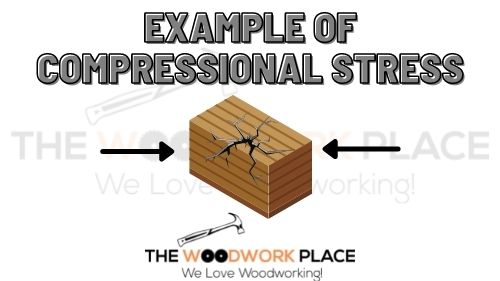
Right… So What About Pecan Wood?
Pecan wood is very hard, certainly much harder than Hard Maple.
You see, Pecan wood registers a solid 1820 lbf on the Janka scale. Making this a tough heavy timber.
Related Post: Is Pecan Wood Really Any Good For Wood Carving?
That’s A Good Thing, Right? Pecan Wood Is Plenty Strong Enough To Become A Cutting Board…
It’s not really a good thing, for two key reasons:
1). This Hardwood Is Too Tough For The Chopping Block
Pecan wood is clearly strong enough to absorb chopping blows. Nevertheless, it is much too hard for your cookware to handle.
And here’s why…optimal cutting board wood should fall within a certain Janka hardness range.
If that timber has a Janka rating of less than 900 lbf, it won’t last too long in the kitchen. But, if it has a Janka rating of more than 1500 lbf, then your chopping utensils won’t last too long either.
But, wood types that fall within this limited Janka rating range, make for great chopping block material.
2). Pecan Wood Has Large Open Pores
Similarly to Red Oak, Pecan wood has large open pores. And this can make it all too easy for raw meat to get snagged in it.
This can then create a cross-contamination risk, if you use Pecan wood as a food prep surface.
So If Pecan Wood Is Out, What Wood Is Best For Cutting Boards?
First off, if you simply want to make a decorative cutting board, Pecan wood is more than suitable.
However, if you want to use your cutting board as a regular food prepping surface, then you’re better off using Hard Maple.
This lumber falls just within that optimal Janka range — what with Hard Maples 1450 lbf rating — making it ideal for cutting boards.
Related Post: Acacia Vs Maple Cutting Boards (4 Key Pros And Cons)
To Wrap Up, Here Are The 3 Key Takeaways From This Post…
- 1). Cutting boards need to be made from wood types that do not have large open pores. Using these open pored woods runs the risk of food cross-contamination.
- 2). Pecan wood has large open pores.
- 3). If you want to make a cutting board, use a better choice hardwood, such as Hard Maple.

